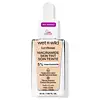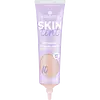What's inside
What's inside
 Key Ingredients
Key Ingredients

 Benefits
Benefits

 Concerns
Concerns

 Ingredients Side-by-side
Ingredients Side-by-side

Water
Skin ConditioningC13-14 Alkane
SolventGlycerin
HumectantNiacinamide
SmoothingHydrogenated Polydecene
EmollientPolyglyceryl-3 Diisostearate
EmulsifyingPropanediol
SolventSilica
AbrasiveVp/Eicosene Copolymer
Calcium Sodium Borosilicate
Lecithin
EmollientSqualane
EmollientPhenoxyethanol
PreservativePvp
Emulsion StabilisingTocopheryl Acetate
AntioxidantQuaternium-90 Bentonite
Ethylhexylglycerin
Skin ConditioningAllantoin
Skin ConditioningBisabolol
MaskingPropylene Carbonate
SolventTocopherol
AntioxidantRibes Nigrum Seed Oil
EmollientOctyldodecanol
EmollientOctyldodecyl Oleate
EmollientOctyldodecyl Stearoyl Stearate
EmollientQuartz
AbrasiveAlcohol
AntimicrobialPaeonia Suffruticosa Root Extract
Skin ProtectingButylene Glycol
HumectantRosmarinus Officinalis Leaf Extract
AntimicrobialSolidago Virgaurea Extract
Skin ConditioningHydrolyzed Hyaluronic Acid
HumectantCI 77891
Cosmetic ColorantMica
Cosmetic ColorantIron Oxides
Water, C13-14 Alkane, Glycerin, Niacinamide, Hydrogenated Polydecene, Polyglyceryl-3 Diisostearate, Propanediol, Silica, Vp/Eicosene Copolymer, Calcium Sodium Borosilicate, Lecithin, Squalane, Phenoxyethanol, Pvp, Tocopheryl Acetate, Quaternium-90 Bentonite, Ethylhexylglycerin, Allantoin, Bisabolol, Propylene Carbonate, Tocopherol, Ribes Nigrum Seed Oil, Octyldodecanol, Octyldodecyl Oleate, Octyldodecyl Stearoyl Stearate, Quartz, Alcohol, Paeonia Suffruticosa Root Extract, Butylene Glycol, Rosmarinus Officinalis Leaf Extract, Solidago Virgaurea Extract, Hydrolyzed Hyaluronic Acid, CI 77891, Mica, Iron Oxides
Water
Skin ConditioningTitanium Dioxide
Cosmetic ColorantTributyl Citrate
SolventButylene Glycol
HumectantDicaprylyl Ether
EmollientEthylhexyl Triazone
UV AbsorberMyristyl Lactate
EmollientC13-15 Alkane
SolventSilica
AbrasiveDiethylamino Hydroxybenzoyl Hexyl Benzoate
UV FilterBis-Ethylhexyloxyphenol Methoxyphenyl Triazine
Skin ConditioningPolyglyceryl-6 Polyricinoleate
EmulsifyingPolyglyceryl-6 Polyhydroxystearate
EmulsifyingTalc
AbrasiveMagnesium Sulfate
Dimethicone/Vinyl Dimethicone Crosspolymer
Skin ConditioningAloe Barbadensis Leaf Juice Powder
Skin ConditioningSodium Hyaluronate
HumectantTocopherol
AntioxidantCetyl Alcohol
EmollientDextrin Palmitate
EmulsifyingPolyglycerin-6
HumectantXanthan Gum
EmulsifyingTriethoxycaprylylsilane
Phenoxyethanol
PreservativeCI 77491
Cosmetic ColorantCI 77492
Cosmetic ColorantCI 77499
Cosmetic ColorantWater, Titanium Dioxide, Tributyl Citrate, Butylene Glycol, Dicaprylyl Ether, Ethylhexyl Triazone, Myristyl Lactate, C13-15 Alkane, Silica, Diethylamino Hydroxybenzoyl Hexyl Benzoate, Bis-Ethylhexyloxyphenol Methoxyphenyl Triazine, Polyglyceryl-6 Polyricinoleate, Polyglyceryl-6 Polyhydroxystearate, Talc, Magnesium Sulfate, Dimethicone/Vinyl Dimethicone Crosspolymer, Aloe Barbadensis Leaf Juice Powder, Sodium Hyaluronate, Tocopherol, Cetyl Alcohol, Dextrin Palmitate, Polyglycerin-6, Xanthan Gum, Triethoxycaprylylsilane, Phenoxyethanol, CI 77491, CI 77492, CI 77499
 Reviews
Reviews

Ingredients Explained
These ingredients are found in both products.
Ingredients higher up in an ingredient list are typically present in a larger amount.
Butylene Glycol (or BG) is used within cosmetic products for a few different reasons:
Overall, Butylene Glycol is a safe and well-rounded ingredient that works well with other ingredients.
Though this ingredient works well with most skin types, some people with sensitive skin may experience a reaction such as allergic rashes, closed comedones, or itchiness.
Learn more about Butylene GlycolPhenoxyethanol is a preservative that has germicide, antimicrobial, and aromatic properties. Studies show that phenoxyethanol can prevent microbial growth. By itself, it has a scent that is similar to that of a rose.
It's often used in formulations along with Caprylyl Glycol to preserve the shelf life of products.
Silica, also known as silicon dioxide, is a naturally occurring mineral. It is used as a fine, spherical, and porous powder in cosmetics.
Though it has exfoliant properties, the function of silica varies depending on the product.
The unique structure of silica enhances the spreadability and adds smoothness, making it a great texture enhancer.
It is also used as an active carrier, emulsifier, and mattifier due to its ability to absorb excess oil.
In some products, tiny microneedles called spicules are made from silica or hydrolyzed sponge. When you rub them in, they lightly polish away dead skin layers and enhance the penetration of active ingredients.
Learn more about SilicaTocopherol (also known as Vitamin E) is a common antioxidant used to help protect the skin from free-radicals and strengthen the skin barrier. It's also fat soluble - this means our skin is great at absorbing it.
Vitamin E also helps keep your natural skin lipids healthy. Your lipid skin barrier naturally consists of lipids, ceramides, and fatty acids. Vitamin E offers extra protection for your skin’s lipid barrier, keeping your skin healthy and nourished.
Another benefit is a bit of UV protection. Vitamin E helps reduce the damage caused by UVB rays. (It should not replace your sunscreen). Combining it with Vitamin C can decrease sunburned cells and hyperpigmentation after UV exposure.
You might have noticed Vitamin E + C often paired together. This is because it is great at stabilizing Vitamin C. Using the two together helps increase the effectiveness of both ingredients.
There are often claims that Vitamin E can reduce/prevent scarring, but these claims haven't been confirmed by scientific research.
Learn more about TocopherolWater. It's the most common cosmetic ingredient of all. You'll usually see it at the top of ingredient lists, meaning that it makes up the largest part of the product.
So why is it so popular? Water most often acts as a solvent - this means that it helps dissolve other ingredients into the formulation.
You'll also recognize water as that liquid we all need to stay alive. If you see this, drink a glass of water. Stay hydrated!
Learn more about Water